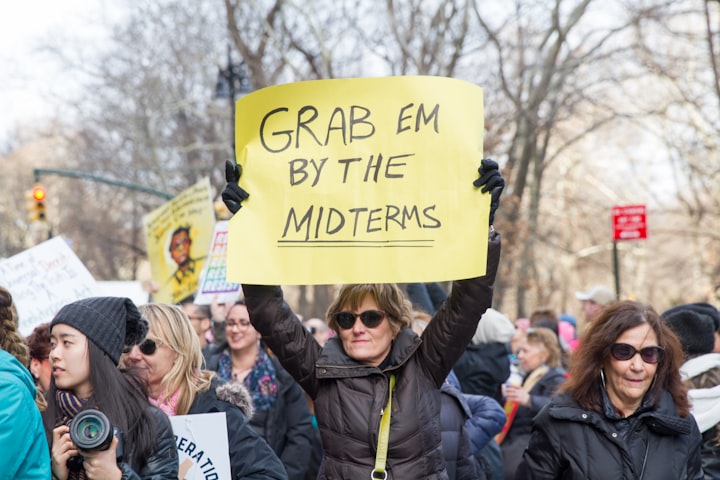
» KEY POINTS
- A ranked point system should be created in voting for the Presidential ticket where the people have up to 3 candidates they can select in order of preference.
- The people should also have a negative vote to remove points from the candidate they do not want to win.
- Netting the ranked choice points and negative points will determine the next President and Vice President of the United States.

Just saying that people should be able to vote for the President and Vice President directly does not actually resolve the issue because that could just mean directing the Electoral College to vote for the popularity winner. This is what has been going on with the “National Popular Vote Interstate Compact” in which States pledge that all of their Electors will go to the winner of the national popular election should the number of States in the compact meet or exceed the number of Electors required to elect the President. While a noble goal, it is still an end-runaround the Constitution and leaves all the same problems of excluding people. Additionally, there are many issues that continue to suppress turnout including when results are available. One of the other reasons why Hawai'i has so low voter turnout is because the election is already decided in the middle of their voting day.
We will return to how to get more involvement, but for now the focus should be on how people would vote for the President and Vice President. This requires a complete re-write of a section of the Constitution and an Amendment:
By Amendment to the Constitution of the United States, Article 2, Section 1, Clause 3 shall be merged with Article/Amendment 12, Clause 1 and together shall read:
The Electors shall meet in their respective states, and vote by ballot for President and Vice-President, one of whom, at least, shall not be an inhabitant of the same state with themselves; they shall name in their ballots the person voted for as President, and in distinct ballots the person voted for as Vice-President, and they shall make distinct lists of all persons voted for as President, and of all persons voted for as Vice-President, and of the number of votes for each, which lists they shall sign and certify, and transmit sealed to the seat of the government of the United States, directed to the President of the Senate; — The President of the Senate shall, in the presence of the Senate and House of Representatives, open all the certificates and the votes shall then be counted; — The person having the greatest number of votes for President, shall be the President, if such number be a majority of the whole number of Electors appointed; and if no person have such majority, then from the persons having the highest numbers not exceeding three on the list of those voted for as President, the House of Representatives shall choose immediately, by ballot, the President. But in choosing the President, the votes shall be taken by states, the representation from each state having one vote; a quorum for this purpose shall consist of a member or members from two-thirds of the states, and a majority of all the states shall be necessary to a choice. — The person having the greatest number of votes as Vice-President, shall be the Vice-President, if such number be a majority of the whole number of Electors appointed, and if no person have a majority, then from the two highest numbers on the list, the Senate shall choose the Vice-President; a quorum for the purpose shall consist of two-thirds of the whole number of Senators, and a majority of the whole number shall be necessary to a choice. But no person constitutionally ineligible to the office of President shall be eligible to that of Vice-President of the United States.
The President and Vice President shall run together on a single ticket and there shall be no criteria for a President or Vice President to appear on the ballots save for meeting the criteria for each position as stated in the Constitution. Eligible voters of the States and Territories shall rank their top three choices for President and Vice President and shall also be granted a single vote against a choice for President and Vice President. A value shall be added to each vote such that the first choice gets three points, the second choice gets two points, and the third choice gets one point. Furthermore, the vote against shall subtract two points. The candidates that receive the net most amount of points shall be the President and Vice President of the United States.
That is quite a bit, so let's us break this down in pieces.
First off, one of the reasons for the 12th Amendment in the first place was because of the 1796 Election when the President (John Adams) and the Vice President (Thomas Jefferson) were in different Parties. This was because the original Constitution did not have the President and Vice President run together but that that the person with the most votes was President and the second most votes was Vice President (Electors had two votes). Even though Adams and Jefferson did have running mates that they intended to be Vice President the votes did not break that way and Adam’s Vice Presidential pick had less votes than Jefferson.
When the Constitution was written, there were no Political Parties and George Washington did not align to any while he was President. Meanwhile, most thought this would not be an issue because the differences were merely ideological and that everyone would still work for what was best for the nation. Unfortunately, as has been proven time-and-time again, those with polar opposite political opinions will not work together unless forced to do so, and the President and Vice President do not have a mechanism that will make them. In order to execute law, a single directive is needed.
Jefferson’s Democratic-Republican Party figured this out for the next election in 1800 and planned to have one of the Electors miscast their vote intentionally so that Jefferson would be the President and Aaron Burr would be the Vice President. Unfortunately, miscommunication made it so nobody knew which Elector was supposed to do this and therefore Jefferson and Burr actually tied, requiring the House of Representatives to decide the election (which incidentally almost elected Burr as President, yet another flaw).
Because of all of that, the 12th Amendment was passed so that President the Vice President were voted on separately and it has generally been upheld to vote for a ticket running together. But we should close that loophole correctly and just say the President and the Vice President are a single ticket item that people are voting for. While it is tempting to force a second-place candidate to be Vice President, the inherent danger to the President of having an enemy be the next up in line overrides that thought.
Within this track, though, is the same situation faced with those being in a Party that the States decide to remove for capricious reasons. There is no reason to restrict any duo from running for President and Vice President save the criteria as laid out by the Constitution, that criteria being:
By Amendment to the Constitution of the United States, Article 2, Section 1, Clause 5 shall read:
No Person except a natural born Citizen, or a Citizen of the United States, at the time of the Adoption of this Constitution, shall be eligible to the Office of President or Vice President; neither shall any Person be eligible to that Office who shall not have attained to the Age of thirty five Years voting maturity as defined by the Constitution and Congress, and been fourteen Years a Resident within the United States.
Age should not be a restriction because if one can vote, one can serve. It is highly unlikely someone young and unknown would be elected President, but there is no reason to restrict that. However, we will maintain the other criteria of being a natural born citizen for now and been 14 years a resident (meaning the person needs to live in the country for the past 14 years in a row). While there may be arguments to allow foreign-born persons to be President and the risk would be minimal nowadays, it is not a requirement to make the country function well. Additionally, this could always be changed with another Amendment later, so we will leave it alone for now.
Now, with so many people on the ballot, how are voters to cast their decisions? Theoretically, their Political Party is irrelevant as anyone could run. Perhaps Political Parties would still run primaries and make decisions about how many of their people will run, but if we also made Amendments so that the Government is out of the Primary game, that will leave the decision up to them. If someone wants to run and meets the criteria, they are on the ballot everywhere. Does that mean hundreds of pairings could be on the ballot? Absolutely! Why should choice be limited?
Instead, we will take a cue from the 12th Amendment again. The way it is set up now is that if no candidate receives a majority of Electoral College votes then the top 3 candidates will be sent to the House of Representatives to decide which one should be President. This is exactly what happened in the 1824 election where not only did the person with the most popular votes (Andrew Jackson) lose the election, but he also lost even though he had the most Electoral College votes!

Because Jackson did not make it over the Electoral College threshold, it forced a runoff between the top three, of which he massively lost. While this has not occurred again, the potential is still there for this to happen. Having the House of Representatives decide the Presidential Election has already shown it will go against the will of the people if the chamber of Congress so desires and therefore should be excluded as a valid method. However, we can take one of the ideas in a top three decision.
If we went with absolute majority of votes, in the 2016 Election Hillary Clinton had 48% of the vote and Donald Trump had 46% of the vote. Now, we cannot assume what the 113 million people who did not vote would have done, so we should assume for now this result reflects the overall desires of the nation. That said, if we extended the “absolute majority” rule with the popular vote, we’d end up in the exact same situation. Gary Johnson had 3% of the vote, Jill Stein had 1%, and everyone else (including Evan McMullin, Darrell Castle, Gloria La Riva, and Bernie Sanders [somehow]) had another 1%. If we wanted a runoff vote with the Top 3 people, it is possible Hillary could have picked up another 2–3%, but it is more likely that Gary Johnson would have picked up enough to still not elect her.
Meanwhile, the expense and time of putting on another election would have been phenomenal. Let us not forget that the election was in November and the President assumes office in January. That means a runoff election would have needed to happen somewhere between Thanksgiving and the winter holidays — and could still have resulted in no clear winner! Other countries and local areas in this nation have dealt with this exact issue and it can result in unfilled position for months on end. That is not acceptable for the President and Vice President of the United States.
Instead, we can take the guessing game out by asking a different question: if your first pick for President cannot be elected, who is your second choice? Who is your third choice? With this, we already have the runoff election complete because we can assign a point value to each of these choices. Your first choice gets 3 points, your second choice gets 2, and your third choice gets 1. Whoever has the most points is the winner as the points would already reflect the backup and backup’s backup will of the people!
Sometimes, people do not have a clear idea of who they want to vote for, but they do know who they do not want as President. That should be reflected in the vote, too, as an allowance for a negative vote. In this case, the voters could give their will to have a candidate lose 2 points. This would not completely negate someone’s first choice vote but would partially remove it while allowing other points to accumulate.
If we make various suppositions, we can estimate how the results would have been for the 2016 Presidential election. Some of the assumptions include:
- Every candidate that received a popular vote was the first choice and got 3 points for that.
- 90% of Democrats and Republican votes will use their negative vote on the opposing Party, as will 40% of all other voters.
- Roughly 1% of votes cast by all other parties will be used against every Third Party and Independent.
- 5% to 10% of every group will use their second and third choice votes for major parties or third parties, depending on relative political alignment.
This could be modeled forever using a ton of other possibilities, but the idea is to get an impression of where this might fall out. Here is what we see:

As you can surmise, Hillary Clinton would still win the election compared to the popular vote, but the Third Parties would get a lot more attention and net points so that it is more likely they will be recognized in the future. Again, a major point of this thesis is to break the oligopoly of the Democratic and Republican Parties and this Amendment is an important step to helping other Parties gain attention. It is worth noting that both Republicans and Democrats engaged in fear mongering during the election saying a Third Party vote would be a waste or — worse — that it would help their opponent get elected. This is just the oligopoly talking to maintain its power and has nothing to do with reality. With 113 million people not voting, nearly 4 million people not allowed to vote, and who knows how many people scared out of voting for who they wanted for fear of the candidate they least liked being elected, it is impossible to say how different these number would turn out. It does not necessarily mean a Third Party would have won, but perhaps the margins would not be so large. Maybe a significant number of people would have voted for Third Parties first, Major Parties Second, and used their negative vote for the other Major Party? We cannot tell until we make the change and allow it to happen.
The Negative Vote is incredibly important in this scheme because it frees people to vote for who they want. Giving people full control and meaning to their vote is the truly virtuous thing to do in a representative democracy. However, even with all of this, a lot more needs to be done to get everyone involved and engaged.

The above piece is a mildly modified excerpt from New & Improved: The United States of America by J.P. Prag, available at booksellers worldwide.

Learn more about author J.P. Prag at www.jpprag.com.

An earlier version of this article appeared on Medium.
About the Creator
J.P. Prag
J.P. Prag is the author of "Aestas ¤ The Yellow Balloon", "Compendium of Humanity's End", "254 Days to Impeachment", "Always Divided, Never United", "New & Improved: The United States of America", and more! Learn more at www.jpprag.com.






Comments
There are no comments for this story
Be the first to respond and start the conversation.